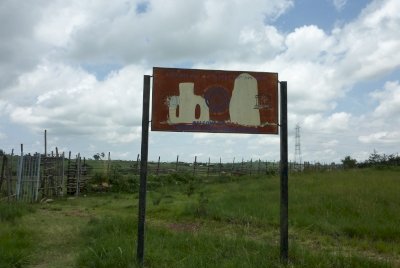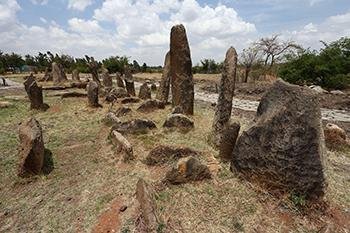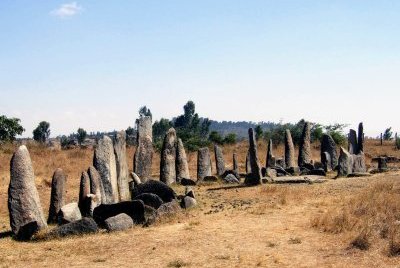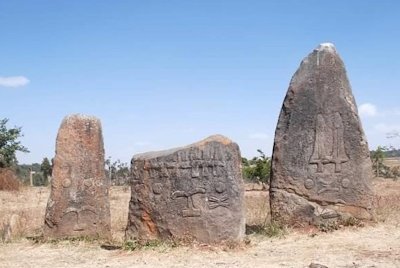Ethiopia
Tiya
Tiya is an archaeological site renowned for its decorated stelae.
These megaliths mark a large, prehistoric burial complex of an ancient Ethiopian culture. The standing stones are decorated with symbols, some of them sword-like. These two groups of in total 36 stelae date from between the 10th and 15th centuries AD. They are seen as the best examples of a larger tradition of megalithic pillar sites in the region.
Community Perspective: “Enigmatic”, but Solivagant and Astraftis made an effort to interpret the site. Tiya can be visited on a (long) day trip from Addis Abeba. It is a very small site and a visit is likely to be underwhelming to the general audience.
Site Info
Official Information
- Full Name
- Tiya (ID: 12)
- Country
- Ethiopia
- Status
-
Inscribed 1980
Site history
History of Tiya
- 1980: Inscribed
- Inscribed
- 1979: Deferred
- Bureau meeting - info requested in 78 still not in place
- 1978: Deferred
- Bureau meeting - info requested
- Type
- Cultural
- Criteria
- i
- iv
Links
- UNESCO
- whc.unesco.org
- Official
-
- ethiopia.travel — Ethiopia Travel Tiya, Adadi Maryam And Melka Kunture
- Related
-
- en.wikipedia.org — Wiki on Tiya
- greatbuildings.com — Photos of the Tiya stelae can be found on Greatbuildings.com
All Links
UNESCO.org
- whc.unesco.org — whc.unesco.org/
Official Website
- ethiopia.travel — Ethiopia Travel Tiya, Adadi Maryam And Melka Kunture
Related Resources
- en.wikipedia.org — Wiki on Tiya
- greatbuildings.com — Photos of the Tiya stelae can be found on Greatbuildings.com
Community Information
- Community Category
- Archaeological site: Prehistoric
Travel Information
Recent Connections
-
No Map
-
Shortest WHS names
4 letters -
Built in the 10th century
earliest stelae date to the 10th Century
Connections of Tiya
- History
-
-
Megalithism
"They are highly representative of an expression of the Ethiopian megalithic period" criterion (iv) - Periodic Reporting
-
- World Heritage Process
-
-
No Map
-
Inscribed at third attempt or more
Def 1978, Def 1979, Ins 1980 -
No Buffer Zone
Periodic Reporting 2001 "Actions ...-to delimit the buffer zone"
-
- Human Activity
-
-
Protective engineering works against flooding
Assistance "Systematic assessment of causes and effects of surface degradation of the Tiya megalithic structures and waterlogged field of the property (16,995 USD Approved amount - 5 Mar 2019) From the 1996 State of Conservation: "improving the maintenance of the grassy surface of the site and the drainage system to avoid flooding during the rainy season."
-
- Constructions
-
-
Stelae
Has 36 standing stones or stelae, "32 of which are engraved with enigmatic symbols, notably swords," -
Cemeteries
"Originally forty-six stelae were erected in the cemetery between the tenth and fifteenth centuries. Archaeological excavations show that the site contains graves. They have been interpreted as having a funerary significance, since there are tombs scattered around the stelae. " - UNESCO Documentation and Periodic Reporting
-
- Timeline
-
-
Built in the 10th century
earliest stelae date to the 10th Century
-
- WHS Names
-
-
Shortest WHS names
4 letters
-
News
No news.
Recent Visitors
Visitors of Tiya
- Alexander Barabanov
- A. Mehmet Haksever
- Artur Anuszewski
- Astraftis
- Atila Ege
- Boj
- David Marton
- Dolemite92
- Elaine McArdle
- Eva Kisgyorgy
- Fan Yibo
- Gernot
- Harry Mitsidis
- Iain Jackson
- Janos
- Jarek Pokrzywnicki
- Jasam
- Jawnbeary
- Jean Lecaillon
- Juha Sjoeblom
- Kjlauer
- Knut
- Kurt Lauer
- Loic Pedras
- Luis Filipe Gaspar
- marcel staron
- maryhattie
- Michael Novins
- Mihai Dascalu
- Philipp Leu
- Piotr Wasil
- Randi Thomsen
- Reza
- Roger Ourset
- Solivagant
- Stanislaw Warwas
- Svein Elias
- Szucs Tamas
- Thomas Buechler
- Thomas van der Walt
- tony0001
- Truls Brekke
- Wojciech Fedoruk
Community Reviews
Show full reviews
Tiya was one of the first things I saw of Ethiopia, on a morning of August in 2015, after having been picked up by our drivers/guides from the airport together with my small group at dawn, after little or no sleep (it seems that my experience was quite similar to Juha's). Our final destination was the south and the Omo valley, but on that first day the guides had planned to bring us (also) here on the way to our first stop-over in Hawassa; from this and the fact that a troupe of a local television was there to take an interview with us, I got the impression that they were trying to promote the site somehow.
Anyway, I didn't know anything of Tiya, but, despite a general sense of negligence (the stelae were in a fenced field with unmown grass, and at the time the only nearby building was a toilet shack), we (as the only visitors) were very well received and I found that the local guide was well prepared and passionate, and could explain us what is known and speculated about these stelae in a good English. Neither is to be taken for granted, and I greatly appreciated it. This surely improved my understanding of the site.
I noticed that my travel companions were disappointed by the visit. I have to admit that the site is not a spectacular one, albeit its position is amidst a very beautiful countryside, dotted with huts and trees. In …
Keep reading 0 comments
Site visited April 2015. The small and puzzling site of Tiya left me with mixed feelings. For me it was the first taste of Ethiopia and as such it was an exciting journey. But if you are not a WHS or cultural history enthusiast the experience could be underwhelming.
Tiya is an early inscription from 1980. Although it is quite near Addis Ababa it is not very easy place to reach. In theory there should be some bus connection but I wouldn’t count on it. In practice the only reasonable way to visit Tiya is to hire a car and a driver which I did via local travel agency.
I had arrived in Ethiopia just a few hours earlier. In the morning, after two hours of sleep, the driver picked me up from my hotel. The journey in the countryside south of Addis Ababa was fascinating as we stopped along the route to admire nice views and meet some shepherds of Oromo people.
After three hours we arrived in the site of Tiya. There was someone who collected a small entrance fee and also a souvenir seller in a small hut. Besides them I was the only visitor.
The site is very small with 36 steles in three clusters. The steles are up to two meters in height and some of them lie on the ground. Almost all the stones have engravings which include swords, circles, false banana trees and some unidentified symbols. There have been different hypotheses about the …
Keep reading 0 comments
it was nice to be there.all the stone and its message is amasing. the site is vere closer to the main road. eventhough it is on of among the world heritage, it's future existance is questionable. the is no facilities for turists or visitors. the whole site is run by only three person. as a studend of cultural related things i felt unhappy about the existing situation. as a resonssible generation we are expected alot to preserve and forwarded it to the future or coming generation
Keep reading 0 comments
A word commonly used regarding Tiya (including in the UNESCO documentation itself) is “Enigmatic”. Despite its inscription as long ago as 1980 remarkably little is known about the c35 strangely carved standing stones situated in a 200 metre square site 85 kms outside Addis Ababa. Which group of people created them? What is the meaning of the carvings? When were they erected? All is vague.
We were told that a number of bodies had been found which had been carbon dated at between the 12th and 14th centuries. All appeared to have been warriors killed in battle. The layout of the stones certainly gives the impression of a row of head stones and graves beyond them. Many are carved with what are clearly swords but other motifs are less clear – a suggestion for a commonly occurring “fountain-like” shape is that it is a “false banana” tree – a significant plant in the drier areas of Ethiopia, providing all year round flour and leaves for houses etc. One flat stone is carved with a figure but there are no others, no script and no recognisable religious symbols from either Christianity or Islam (the 2 main religions of the region across the relevant period).
If you have a spare day in Addis and transport (you might just about make it return in a day on public transport on the road to Butajira but I wouldn’t bank on it) it is worth taking in this WHS (there is also a …
Keep reading 0 comments
